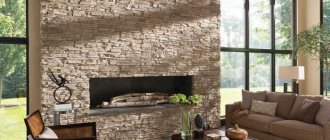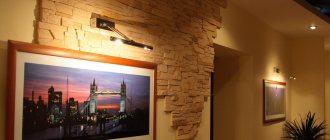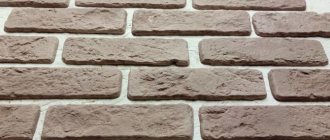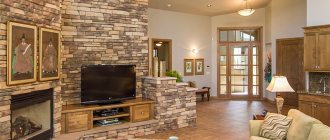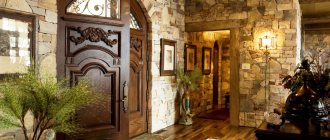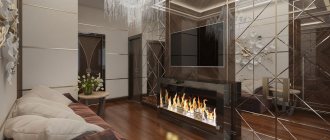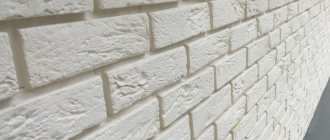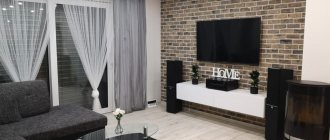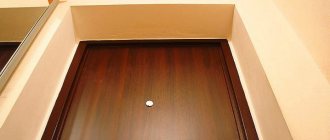Home » Decor » Wall decoration
DesignWall decoration
Veronica Bondar
21747 Views
Stone interior decoration is one of my favorite ways to transform an interior. This solution allows you to emphasize the individuality, taste and material wealth of the owners of a house or apartment, and also creates an unusually cozy atmosphere and an amazing indoor microclimate. A great tool for creating designs with character and strength. Everything will be discussed in more detail later in the article.
What is artificial stone? TOP 7 advantages
Three types of artificial stone are used for interior decoration of the apartment: agglomerate, porcelain stoneware and cement-based stone. I recommend the latter option, since it is characterized by wide decorative properties, a fairly simple production method and behaves well during the installation process.
There are many varieties of artificial stone
Among the main advantages of artificial stone, the following qualities are worth noting:
1 durability - retains its appearance for decades;
2 strength - resistant to mechanical loads;
3 environmental friendliness - completely safe for human health and the environment;
4 fire resistance - does not burn;
5 variety of colors and textures - allows you to create any interior;
6 affordable price - offered in various price categories and much cheaper than natural
It may differ not only in color, but also in shape
Artificial stone allows you not only to make a room more expressive and bright, but also to improve its technological and functional properties. It fits perfectly into most modern styles, is very mobile and goes well with other methods of interior decoration.
Advantages and disadvantages of finishing stone walls inside an apartment
Finishing with decorative stone in an apartment has its pros and cons. The positive aspects include:
- resistance to mechanical stress;
- combination of price and quality;
- the ability to complete the work independently in a short period of time;
- the absence of harmful additives and reagents in the composition of artificial stone and the environmental safety of natural stones;
- resistance to humidity and water ingress.
Among the shortcomings the following points stand out:
- the material is more expensive than conventional wallpaper;
- heavy weight and complex installation of a natural product;
- the need for treatment with disinfectants;
- Some varieties are poorly susceptible to restoration.
TOP 6 types of natural stone and their features
Natural stone is quite capricious to work with, but at the same time this material has a unique texture and color, is durable and stable, environmentally friendly and especially luxurious. It is difficult to imagine many interiors without such a stylistic solution.
Sometimes it’s simply impossible to imagine a future interior without stone
There are several types of natural stone that are popular for interior decoration:
1 marble - distinguished by a variety of colors, durability and high price;
2granite - easy to care for and resistant to mechanical damage;
3travertine - resistant to moisture, popular for decorating bathrooms;
4 limestone - available in a wide variety of colors, easy to work with, quite inexpensive, but also very fragile;
5 shell rock - characterized by the presence of a porous structure, fragile, require additional coating with special materials;
6tufa - has high thermal insulation properties, is easy to saw, and is not resistant to moisture.
Granite is often used as the main material for countertops
To make the interior of a room with stone harmonious, it must be diluted with softer materials. This could be decorative plaster, wallpaper, painted walls, etc. A large number of rough surfaces in a room can create an undesirable effect and make the atmosphere cold and uncomfortable.
We dilute it with plaster so that the interior does not look very rough
Color spectrum
There is a large number of color palettes for decorative stonework. Experts advise us to use this or that color depending on the parameters of the room: area, availability of lighting, busy interior. White color is the leader in use in narrow, small corridors, hallways, and bathrooms. It creates a visual increase in the room. Warm shades and grays work well in larger spaces along with wooden materials.
How to use in the interior
I want to share with you a few tips on using decorative stone for interior decoration:
- the basic one, unifying the entire style of an apartment or house, is the cladding of window and door openings. Here you can choose imitation brick, which fits perfectly into any style;
- An excellent backdrop for a large TV in the living room will be decorating part of the wall. If the room has a fireplace, then it can be lined with this material. This is a win-win option that carries a powerful stylistic load;
- Flemish brick imitation is suitable for decorating any room, allowing you to create a special atmosphere in the room;
- material with a rocky surface goes well with various pieces of decoration, plaster, wallpaper and painted walls;
- The kitchen apron can be lined with stone, creating a continuous space and a very stylish interior. In this case, it must be varnished to facilitate daily cleaning and emphasize the structure of the selected material.
A win-win option - facing the fireplace with stone
Peculiarities
Not every apartment can accommodate an additional brick row - buildings these days are built from metal and concrete, wood and frame structures have become the norm. Not every structure can withstand heavy brickwork. But you shouldn’t give up such a spectacular design option. An alternative could be gypsum tiles designed to look like brick.
It, like any other material, has certain pros and cons, knowledge of which will help you make the right choice.
Advantages:
- Safety. Gypsum is a material of natural origin, therefore, products based on it are environmentally friendly.
- Durability. Compared to many other finishing options, it has greater strength that is maintained throughout its service life. Often used in places most susceptible to abrasion and mechanical stress.
- Thermal insulation. Due to its low thermal conductivity, it retains heat inside the room, preventing the cold from penetrating outside. A wall covered with such material will never freeze.
- Noise insulation. The density of the material is high, sound permeability is low, and accordingly, noise penetration is minimized.
- Fire resistance. Withstands direct flame combustion temperatures and can be used for direct lining of stoves and fireplaces. When heated, it does not emit any hazardous substances.
- Maintaining a comfortable indoor microclimate. Absorbs excess moisture from the air, releases it in case of excessive dryness, and evens out the temperature of the surrounding space.
- The ability to create a realistic texture, place accents, and emphasize the dynamism of the interior.
- Weight. Gluing can be carried out on any wall without reinforcement using almost any adhesive, and does not carry a global load on the floors.
- Ease of installation and processing. You can start work with absolutely no experience.
- There is no need to purchase additional equipment or special materials.
- Price. The price/quality ratio is ideal. The price of the material is low, moreover, it is possible to manufacture it yourself.
Flaws:
- More suitable for interior than exterior work.
- Excessive hygroscopicity is a contraindication to placing the material in street decoration; however, today the production of gypsum-cement boards has been launched, which is quite suitable for exterior finishing.
- Increased fragility. This indicator can be reduced by adding special substances at the manufacturing stage and treating the surface with them after installation.
- Difficulty in care. An untreated gypsum surface can accumulate dust.
- When tiles are placed in a room exposed to high humidity, they must be treated with additional protective and water-repellent solutions.
Finishing rules
When the decision in favor of decorative stone has been made, it is necessary to take into account a few simple rules, the observance of which will allow you to create truly luxurious interiors.
You should carefully consider options for proper lighting of the surface where artificial stone will be present. Small lamps that fit the interior concept can be mounted on the walls.
Additional lighting for the stone-trimmed area
Another great tip is to combine stone with indoor plants. This material harmonizes perfectly with green. If you place beautiful indoor flowers near the decorated wall, the decoration with decorative stone will become especially majestic.
Lighting directly affects the appearance and human perception of the structure of the finishing material. Proper additional lighting of decorated walls, floors or ceilings will create a unique design effect. The incidence of light rays on a stone surface visually improves the structure and beauty of the selected material.
Additional lighting using the ceiling
If stone is used to cover the walls in the hallway, then lighting should be on both walls. When you can’t create a lighting design yourself, you can turn to the help of a specialist. I never tire of emphasizing that a lighting system can radically change the interior and its perception.
Photo ideas for decorating living room walls with stone
If you notice an error, video or link that doesn't work, please select a piece of text and click Ctrl+Enter.
0
In which rooms can decorative stone be used?
Decorative stone ennobles any room, making it especially atmospheric and chic. Today, this material has begun to be boldly used for decorating children's rooms, balconies and baths. Most often it is used in the following areas:
decoration . This option indicates the high status and sense of taste of the apartment owners. It is recommended to use it to decorate one or several zones, or to completely cover one of the walls. Depending on the color, you can achieve different visual effects: light visually expands the space, while dark absorbs it;
Popular stone cladding in the hallway
Living room Strengthening individual zones. A place to relax, a fireplace, a library, a TV or a stereo system - selective use allows you to create coziness and comfort in the living room, making it luxurious and modern;
Living room
Kitchen Selecting a dining or working area, creating a kitchen “apron”. Decorative stone is resistant to moisture and vapor. It is easy to care for and fits perfectly into any size kitchen;
Very easy to clean and moisture resistant
Bedroom It has been proven that such finishing material has an excellent effect on relaxing the mind, helping to cope with the whirlwind of thoughts and fall asleep faster. At the same time, it can also be used to decorate an office, since if brighter and more saturated colors are used, it, on the contrary, increases efficiency and enhances imagination.
Promotes an atmosphere of calm and comfort
Photo gallery - even more ideas
In the photo selection below you will see how else you can use decorative stone in the interior. The gallery of images includes the most interesting design solutions for finishing stairs, niches and arches.
Sources
- https://m-strana.ru/design/sposoby-ispolzovaniya-dekorativnogo-kamnya-v-interere/
- https://ReHouz.info/dekorativnyj-kamen-v-interere-foto/
- https://www.InMyRoom.ru/posts/16103-dekorativnyj-kamen-v-interere-s-foto
- https://www.dizainvfoto.ru/dekor/dekorativnyj-kamen-v-interere-vse-sekrety-izyskannoj-otdelki.html
- https://design-homes.ru/idei-dlya-doma/ispolzovanie-kamnya-v-interere-kvartiry-vidy-sochetaniya-65-foto
- https://stroyday.ru/remont-kvartiry/steny-i-potolok/iskusstvennyj-kamen-v-interere.html
- https://ars.ru/vnutrennyaya-otdelka-pod-kamen-v-raznyh-komnatah/
- https://J.Etagi.com/ps/otdelka-dekorativnym-kamnem/
- https://www.ivd.ru/dizajn-i-dekor/dekorirovanie/7-tipov-iskusstvennogo-i-naturalnogo-kamnya-i-nyuansy-ih-ispolzovaniya-v-interere-35451
- https://Trizio.ru/dekorativniy-kamen-v-interere-foto-20
How to choose a stone for the interior
The appearance of the stone in the interior depends on its size, color and corrugation. When choosing one option or another, the overall style of the room is taken into account.
We support interior styling
Here are some recommendations from experts to help you make the right choice:
- if the room has darkened sides, then it is best to use light materials with a sunny orange tint;
- if the option of green, gray or blue color is chosen, then no more than 2/3 of the wall height can be covered with it. Failure to comply with this rule will lead to the fact that the room will visually appear smaller, and the atmosphere in it will become more difficult and boring;
- when combining different colors, the transition between them should be smooth and neat;
- when choosing steel shades, dilute them with light objects: furniture, decor, etc.
There can never be too much stone even in the living room
Decorative stones have different corrugations and create different effects. Light corrugation is suitable for absolutely any design. Strong corrugation has a powerful visual effect and can completely shift attention to itself, therefore it requires proximity to more modest elements of decor and finishing.
You need to pay attention to the corrugation of the surface of the stones
Decorating room surfaces
- Walls
Walls with masonry are stylish and even strict. Who would have thought that stone could bring warmth, comfort and a finished look to the entire space. The first thing you need to do is choose the material itself: brick, cobblestone, river stone. It is also necessary to decide on the size: solid layers or small elements, what exactly will be displayed on the wall. There are many advantages to this decor: walls decorated with stone elements create additional insulation. And this is important, especially in the conditions of standard apartments. Such a wall seems to emerge from nature or a fairy tale, diluting the modern interior. It is necessary to think about proper lighting.
- Floor
Stone flooring has been popular for a long time. There is a wide range of finishing options. But there are also limitations: some types of material are quite fragile, they can easily be damaged by something sharp or careless movement. It will be completely unsafe to walk on it. An interesting option will turn out if you use pebbles in the shower, bathroom, or hallway. In the kitchen, such a covering will be very convenient.
- Fireplace
A fireplace trimmed with stone looks chic and elegant. A fireplace will create a cozy and fabulous atmosphere around you, where friends and family will want to gather. For many centuries in a row, finishing was done with brick. Its fire resistance ensured its popularity. Today, other materials are used, their properties are similar to the thermal properties of brick: tiles made of baked clay, porcelain stoneware, natural or artificial stone. All these finishing materials can withstand high temperatures and protect against the penetration of moisture and soot.
- Ladder
Another option that designers borrowed from the Middle Ages. The stone steps look as close to nature as possible. They are durable and will last for many years. This finish is used mainly in large houses and cottages. There is an option to use partial masonry, laying masonry over wooden layers. You can also use artificial stone. This will reduce costs
- Doors, arches, niches
Many interior elements can be decorated with stonework. The stone on both sides of the door will emphasize the informal atmosphere and style of the room, and will also draw attention to the canvas itself. Arches are often decorated with stone. In an ordinary interior, such an arch will focus attention and give a special charm to the room. A niche lined with stone can also serve as a decorative element. On its background you can place flowers, panels, paintings, TV. And all this will fit well into any interior style.
Stone finishing in various styles
Decorative stone fits into any interior design. However, depending on the chosen style, such finishing material should have its own characteristics:
1 “loft” style is a brutal, clear and very popular style in modern society. It is difficult to imagine it without brickwork, which can be made in a wide variety of colors, ranging from light to gray and orange shades;
Brickwork on walls in loft style
2 rustic styles such as Provence and country. These trends are based on the use of natural materials; try combining rough brickwork with natural wood, choosing neutral natural shades. This will create a unique atmosphere of coziness, a simple and comfortable life;
Country style finishing
3minimalism is a restrained style that imposes its own requirements on the use of stone. In this case, it is important to choose the most accurate masonry, carefully sand the seams and joints;
Living room in minimalist style
4eclecticism is a style in which you can experiment. It blossoms from the effect of mixing different decorative tools. Here you can safely use bright shades in combination with neutral base colors.
Bright eclecticism cannot help but attract your attention
Mold does not grow on decorative stone. This is an excellent solution for absolutely any room.
Using this material you can hide many imperfections
National and ecological styles
Ethnic styles are very diverse, but several trends should be highlighted that attract natural stone.
The Scandinavian style was formed in harsh landscapes, rocky mountains and hills. Therefore, stone is a natural part of home design. Against the background of light walls, stone tiles look expressive. Use natural decorative textures in gray and yellow tones. Stone is present not only as decoration on walls and floor coverings - countertops are often made from it.
Japanese interior of a bright hall with decorative stone Source dd-restaurant.ru
A characteristic feature of Japanese minimalism is the desire to use natural materials and textures. Wood predominates in the interior; natural stone is used as a companion.
Non-standard use
For those who believe that decorating a wall using decorative stone is too simple a solution, there are more daring proposals:
Decorating the ceiling This method allows you to achieve the effect of antiquity. Due to the right combination with interior items and decorative elements, you can create the feeling of a medieval castle or a rich old mansion. In this case, spot lighting looks advantageous;
Create the feeling of a medieval castle
Stone door An excellent option for disguising the door to an office or any other room. For this, decorative tiles with an appropriate pattern are used;
Concealed door
Niche made of textured material. An excellent solution for bedrooms, it creates the feeling that a person falls asleep in the most natural conditions. I love stone niches in living rooms, dining rooms and dens;
Decorating a stone niche for a bedroom - comfort and coziness are guaranteed
Winter garden You can't think of a better combination than flowers, stone and trees. Due to its technical properties, this material is excellent for interior decoration of a winter garden;
Winter Garden
Mirror framing This option will fit into any interior. The framing effect can also be used when working with aquariums, windows, paintings and various openings;
Combinations of stone and mirror
Creating decorative panels on the walls With the help of decorative stone, you can show your imagination and get extraordinary designs that will become an exceptional addition to your interior.
The panel on the wall made of stones looks beautiful
Combinations of stone with other finishing materials
The most harmonious combinations:
- Tree. This combination will give the design a special originality, combining rustic simplicity, industrial brutality and natural grace.
- Wallpaper. Decorative stone, due to its uniqueness, can be easily combined with any wallpaper or even photo wallpaper.
- Tile. An ideal duet, distinguished by naturalness and at the same time original creativity.
- Decorative plaster. It is a very successful tandem that always looks noble and elegant.
- Painting. This combination is a classic and most commonly used design solution.
The photo shows a decorative stone combined with photo wallpaper in the interior of a modern living room.
Various combinations will give the atmosphere a special historicity, add natural motifs to it and enhance the naturalness of the design.
What is better to replace
There is a great way to save money and create a stone-like surface - using decorative plaster. In appearance and similarity of installation, this option can be compared with natural stone. It allows you to create the surface of the desired relief.
Stone imitation that you can't tell apart
The advantages of this material are obvious: ease of installation, affordable price, wide variety of colors and textures. Suitable for decorating walls, floors, ceilings and even furniture. It creates a uniform, beautiful surface without seams or joints and is safe for human health.
Very convenient and practical
As a rule, to use decorative plaster you do not need to pre-level the walls. Another way is to use plastic panels with a stone effect, tiles, 3D wallpaper, etc.
The main thing is not to overdo it with finishing, so as not to look cluttered
VIDEO: Add stone to the interior
Artificial stone finishing
How best to update your interior using decorative stone
Features of interior design with decorative tiles
Decorating interiors with decorative stone is a frequently used technique among designers. The materials have a number of advantages:
- aesthetic appeal;
- wide range of textures and colors;
- versatility, suitable for decorating different rooms;
- durability;
- ease of care;
- low cost.
Decorative stone in the interior is a stylish, practical, reliable decor.
Photo
Stonington ResidenceRead: Mosquito net. Peculiarities
Let's discuss this article together:
Click to cancel reply.
Necessary tools for DIY masonry
For DIY installation you will need many tools:
- spatulas - regular and serrated;
- metal tape measure;
- building level;
- rubber hammer;
- square;
- syringe gun;
- mixer for preparing glue;
- grinder with a disc for stone;
- brush or roller;
- brush with iron teeth;
- wooden block, beacons;
- containers for grout, glue;
- brush for smoothing seams,
- sprayer for water repellent,
- adhesive mixture.
Types of coating
When you see a hallway trimmed with decorative stone, you can’t even imagine what variety of materials can be used for its cladding. Both natural and artificial elements are used. Real stones give the room an original, unique charm; each of them has its own individual texture and coloring. Due to their high cost and heavy weight, they may not always be applicable. In this case, analogues take over.
Stone-effect wallpaper in the hallway Source mebel-go.ru
Outwardly, they are similar to natural materials; it is almost impossible to find differences at a superficial glance. Modern technologies make it possible to create an imitation of any texture and color scheme that can be matched to any style. This becomes the reason for the popularity of such cladding; moreover, the list of materials from which decorative stone is made is impressive:
- Gypsum.
- Cement-sand mixture.
- Agglomerate.
- Granite, marble and quartzite crumbs.
- Porcelain tiles.
- Plastic.
- Flexible sandstone.
Wall decoration: stone imitation Source stenaprofi.ru
Natural stone is most often used for cladding external facades. For interior decoration, it is more practical to use artificial. Conventionally, all materials can be divided into 2 categories: sandstone and decorative tiles.
Stonework in the hallway Source sam-sebe-dizainer.com/
Modern interior Source modernplace.ru
See also: Catalog of companies that specialize in finishing materials.
About composition and varieties
This decorative material was developed in Germany about ten years ago. It is known as flexible (or soft) stone, flexible sandstone, stone veneer or stone wallpaper, and is notable not only for its appearance, but also for its method of manufacture and use. The facing material consists of the following three layers:
- The basis. Special textile backing or non-woven fabric (agrocanvas).
- Adhesive substance. A polymer (acrylic), which has binding properties, fixes the outer layer and gives flexibility.
Imitation brickwork Source img.aviarydecor.com
- Decorative layer. Fine chips obtained from natural sandstone, quartz, marble or granite; does not crumble, does not fade or crack.
The flexibility of the material is ensured by the fact that a small gap is maintained between the crumb particles. Manufacturers offer the material in roll or tile format.
In interior design, tiles in formats from 200x300 to 950x1200 mm are in demand. The length of stone wallpaper varies between 2-4 m, the width varies within a meter.
Thickness of soft stone Source art-tse.by
